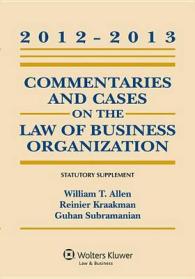- ホーム
- > 洋書
- > 英文書
- > Psychology
Full Description
Addresses unconscious repetition, a concept that is crucial to an understanding of Freudian and Lacanian psychoanalysis.
In Psychoanalysis and Repetition, Juan-David Nasio, one of the leading contemporary Lacanian psychoanalysts in France, argues that unconscious repetition represents the core of psychoanalysis as well as no less than the fundamental constitution of the human being. Through repetition, the unconscious memory of the past erupts, without our knowledge, in our choices and actions, to such an extent that, for Nasio, we are our past in action. While Nasio explains that repetition is both healthy and pathological, the book is primarily concerned with the repetition of unconscious trauma, as trauma engenders trauma, through unconscious fantasms that are expressed, in turn, as symptoms. Through vivid clinical examples, as well as trenchant theoretical explications involving repetition, Nasio illuminates a range of fundamental concepts in Freud and Lacan and offers a rethinking of the psychoanalytic tradition in the context of this theme. Nasio's approach is richly interdisciplinary, incorporating passages from philosophers Descartes and Spinoza, for example, and from such literary figures as Pindar, Proust, and Verlaine. The interdisciplinary fabric of Nasio's discourse conveys the crucial importance of the concept of repetition in psychoanalysis and in the human condition.
Contents
Translator's Acknowledgments
Preface to the English Language Edition: A Conversation with Dr. Nasio
Part I.
A Clinical Experience in which the Psychoanalyst Listens to His or Her Patient While Being Mindful of the Concept of Repetition
Twofold Empathy: The Exclusive Skill of the Psychoanalyst
A General Definition of Repetition
The Beneficial Effects of Healthy Repetition: Self-Preservation, Self-Fulfillment, and Identity Formation
Three Modes of the Return of Our Past: In Our Consciousness, in Our Healthy Acts, and in Our Pathological Actions
Pathological Repetition is the Compulsive Return of a Traumatic Past that Erupts in the Present as a Symptom or as an Impulsive Action
Two Modalities of Pathological Repetition: Temporal Repetition and Topological Repetition
Figures 1 and 2: Two Categories of Pathological Repetition: Temporal and Topological
The Drive is the Compulsive Force of Jouissance
The Lacanian Theory of Repetition: The Unconscious is Structured as a Repetition Automatism
Diagram 1: Repetition According to Lacan
An Example of Pathological Repetition: Bernard, or the Uncontrollable and Repetitive Need to be Humiliated
Psychoanalytic Treatment of Pathological Repetition through its Revivification
Diagram 2: A Concluding Diagram
Healthy Repetition
Pathological Repetition
Therapeutic Revivification
Part II.
Excerpts from Freud and Lacan on Repetition, Preceded by our Commentaries
Figure 1: Schema of Deferred Action
Figure 2: Engendering the Subject of the Unconscious at the Point of Closure, C, of the Repetitive Loop
Index







